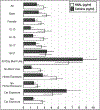Sources and Biomarkers of Secondhand Tobacco Smoke Exposure in Urban Adolescents
- PMID: 31866460
- PMCID: PMC7967984
- DOI: 10.1016/j.acap.2019.12.006
Sources and Biomarkers of Secondhand Tobacco Smoke Exposure in Urban Adolescents
Abstract
Objective: In an urban adolescent population, we evaluated sources of exposure to secondhand smoke exposure (SHS), examined differences in exposure by race/ethnicity, age and sex, and determined the relationship between exposure source(s) and the biomarkers cotinine and NNAL.
Methods: Participants were recruited from a public hospital-based outpatient clinic in San Francisco, CA, USA.
Results: Of a sample of N = 298 adolescents screened, 235 were biologically confirmed to be exposed to tobacco smoke. Of those, N = 16 were active smokers and N = 219 were exposed to SHS; 91 (39%) were heavily SHS exposed (median cotinine = 0.76 ng/mL) and 128 (54%) had light SHS exposure (median cotinine = 0.11 ng/mL). Within those SHS exposed, the most common source of exposure was in a public area. No significant racial/ethnic differences were found, although African American adolescents were more likely to live in a home that allowed smoking. Older adolescents were more likely to be exposed across several difference sources, and females more likely to be exposed in a car and in public areas. Past 7-day exposure in the home, in a car, and current blunt use were significantly related to biomarkers of exposure.
Conclusions: Urban adolescents are exposed to SHS across a variety of sources. Although exposure in a public area is most common, exposure in the home and in cars significantly influences tobacco biomarker levels. Interventions to reduce exposure would have the greatest impact in this population if they focused on reducing exposure in the home and in cars. History of blunt use is a strong determinant of tobacco exposure.
Keywords: adolescents; cotinine; secondhand smoke; sensitive populations.
Copyright © 2019 Academic Pediatric Association. Published by Elsevier Inc. All rights reserved.
Conflict of interest statement
Neal L. Benowitz is a consultant to pharmaceutical companies that market or are developing medications to aid smoking cessation and has served as a paid expert witness in litigation against tobacco companies.The other authors have no conflicts of interest to disclose.
Figures
References
-
- U.S. Department of Health and Human Services. The Health Consequences of Involuntary Exposure to Tobacco Smoke: A Report of the Surgeon General. Atlanta, GA: Centers for Disease Control and Prevention; 2006.
-
- US Department of Health and Human Services. How Tobacco Smoke Causes Disease. What It Means to You. Atlanta, GA: Centers for Disease Control and Prevention; 2010.
-
- Royal College of Physicians (RCP). Passive Smoking and Children. A Report by the Tobacco Advisory Group. London: RCP; 2010.
-
- Shields M Smoking-prevalence, bans and exposure to second-hand smoke. Health Rep. 2007;18:67. - PubMed
Publication types
MeSH terms
Substances
Grants and funding
LinkOut - more resources
Full Text Sources
Medical
Miscellaneous


